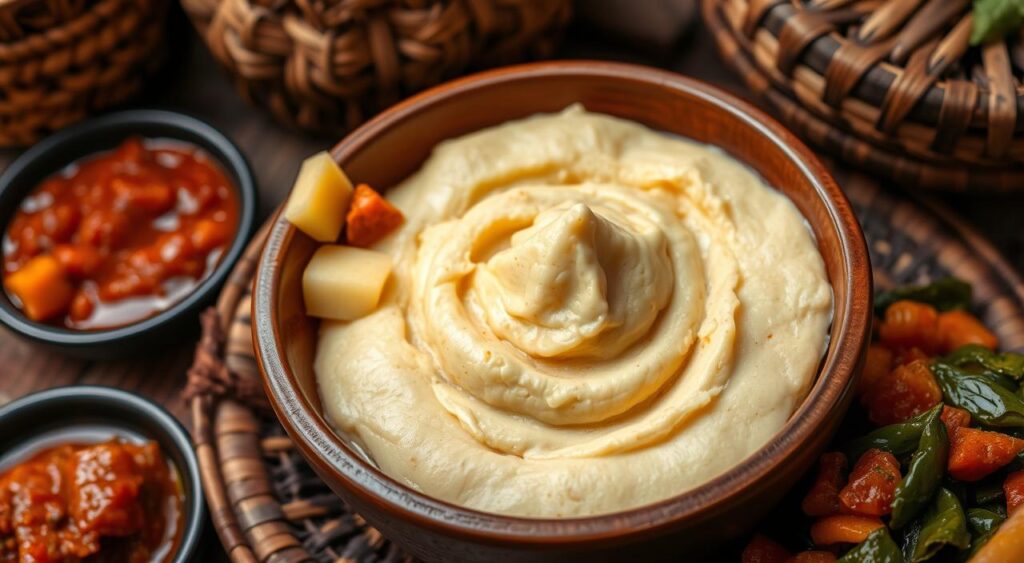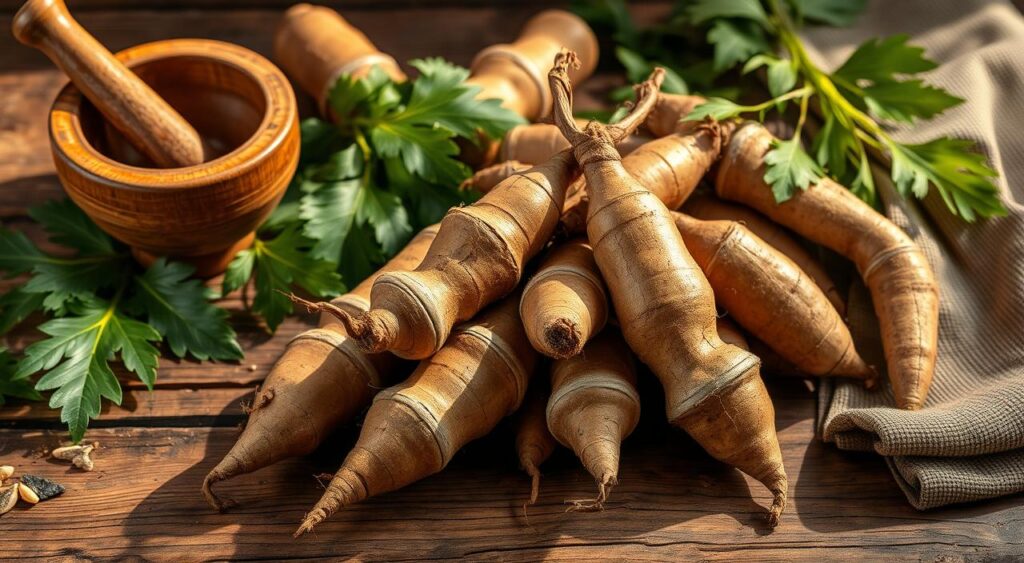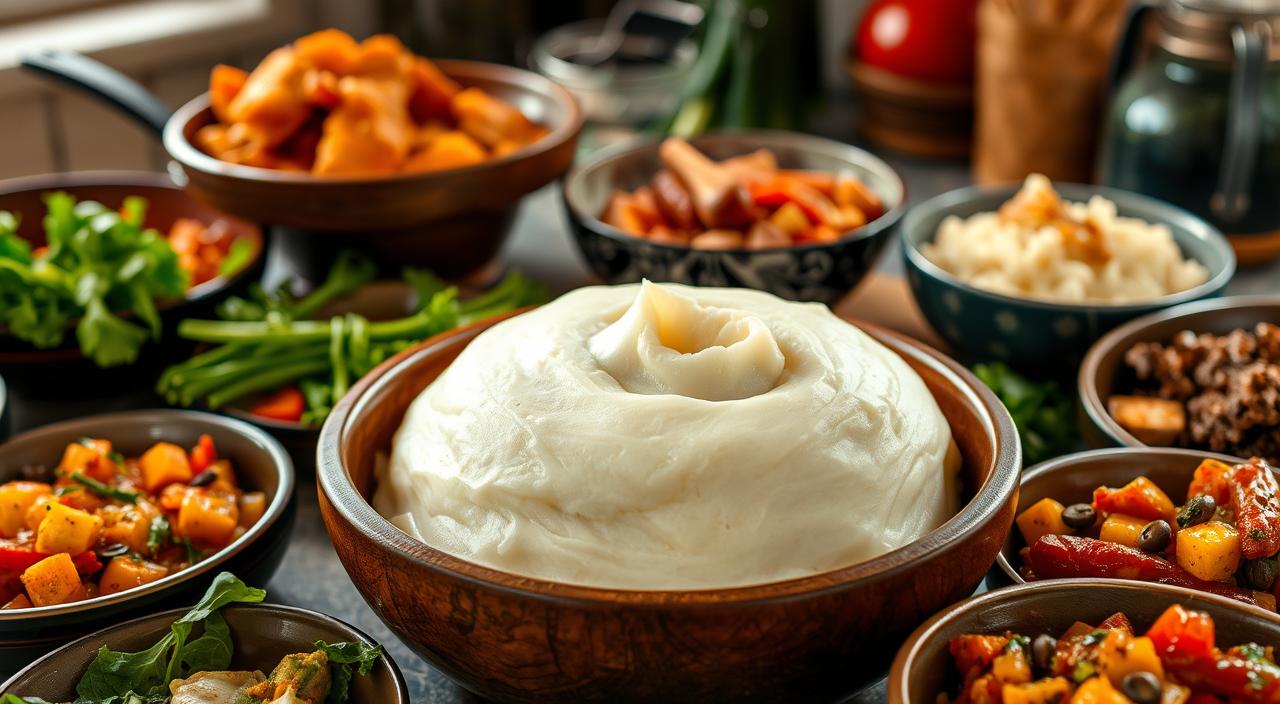The smell of freshly pounded yam takes me back to my grandmother’s kitchen in Nigeria. As a kid, I loved watching her use a wooden pestle. She turned yams into a smooth, elastic dough – the heart of pounded yam.
This dish was a big part of our family’s traditions. It was served at special times and brought us together. It’s a dish that holds a lot of meaning.
If you’ve tried pounded yam, you know its warmth. If not, I’m here to teach you how to make it at home. With a few ingredients and some effort, you can make this Nigerian dish. It will add a new flavor to your cooking.
Understanding Traditional Pounded Yam: A West African Staple

Pounded yam is a key dish in West African cuisine, especially in Nigeria. It’s made from true yams or African yams. These are different from the sweet potatoes called “yams” in the U.S.
Cultural Significance in Nigerian Cuisine
In Nigeria, pounded yam is very important to the Yoruba people. It’s a dish they love. Making it is a group effort, with everyone helping to pound it with a mortar and pestle.
The Role of Pounded Yam in African Gatherings
Pounded yam is a big part of African celebrations. It’s served at weddings, naming ceremonies, and religious events. It goes well with Nigerian soups and stews, feeding both body and soul.
Difference Between True Yams and Sweet Potatoes
True yams are different from sweet potatoes called “yams” in the U.S. Yams are starchier and have a unique taste. They are not the same as sweet potatoes.
Learning about pounded yam’s cultural importance and unique taste helps us appreciate West African cuisine. It shows how pounded yam is a key part of swallow dishes and community events.
“Pounded yam is not just a dish; it’s a cultural expression, a shared experience that brings people together and celebrates the vibrant diversity of West African cuisine.”
Essential Ingredients and Equipment for Pounded Yam

Pounded yam is a favorite in West Africa. It needs just a few things to make. The main ingredient is the African yam or puna yam. It has dark brown skin and off-white flesh.
These yams should be picked at least three months before for the best taste. You also need water, and how much depends on the yam’s dryness. To make it, you’ll need a pot, a sharp knife, and a mortar and pestle. Or, you can use a food processor for a smoother texture.
“Pounded yam is a cornerstone of Nigerian culture and is often prepared during celebrations, gatherings, and family meals.”
Many Nigerians still use a mortar and pestle to make pounded yam. But, some prefer stand mixers or yam pounder machines. Pounded yam is great with many Nigerian dishes. It’s also full of vitamins, minerals, fiber, and carbs.
To make pounded yam, peel, cut, boil, pound, and shape the yam. The size and type of yam affect the cooking time and texture. It’s best served hot with Nigerian soups and stews.
Selecting and Preparing the Perfect Yam
Choosing the right yams is key to making perfect pounded yam. Look for yams that are at least three months old. These are sweeter and better for pounding. Also, yams with fewer ridges are easier to pound.
Identifying Quality African Yams
When picking yams, check them carefully. The skin should be firm and without bruises. Yams with stiff spikes are better for pounding. Stay away from wrinkled or soft yams for the best result.
Proper Cleaning and Peeling Techniques
After picking your yams, prepare them. Use a sharp knife to peel off the brown layer. Proper peeling is crucial to achieve the desired texture and flavor. Rinse the yams well to remove dirt.
Cutting and Size Considerations
Cut the yams into even pieces, about 1/2 inch thick. This ensures they cook evenly and are easy to pound. The size of the yam chunks is important, as smaller pieces will cook faster and result in a smoother texture. Keep the peeled and cut yams in cool water until cooking.
Step-by-Step Cooking Process
To make perfect pounded yam at home, just follow these simple steps. Start by placing boiled yam chunks in a pot. Add just enough water to cover them slightly. Bring the pot to a boil and cook for 15-20 minutes, until they’re tender.
After cooking, drain the yams well in a colander. Keep some cooking water aside for later. The yams should be soft but not too watery. Boiling the yams right is key for the perfect texture.
“The key to delicious pounded yam is in the cooking process. Undercooking can make the final dish tough, while overcooking can result in a mushy, undesirable texture.”
Next, you can either pound the yams in a mortar or use a food processor. Both ways work well, depending on what you prefer. As you pound or process, add a bit of reserved water at a time. This helps get the yams smooth and creamy. The cooking time for yams and adding water carefully are crucial for the right texture.
Remember, boiling the yams is a key step in making pounded yam. By following these steps, you can make delicious pounded yam at home. Enjoy it with your favorite West African dishes.
Traditional vs Modern Preparation Methods
Pounded yam is a favorite in West Africa. It’s made the old way with a wooden mortar and pestle. This method needs a lot of strength and skill. The yams are pounded until they become a smooth, elastic dough.
Mortar and Pestle Technique
Pounding yams by hand is hard work but it’s loved in many African homes. It lets cooks control the texture perfectly. This way, the dough is stretchy and soft, with no yam pieces.
Food Processor Method
Now, people use food processors to make pounding easier. They blend the boiled yams to get a smooth texture. They pulse the mix for 20-30 seconds, adding water as needed to get the right consistency.
Tips for Both Approaches
The aim is to make a soft, stretchy pounded yam. Whether using a mortar and pestle or a food processor, the goal is the same. Work the mix until it’s smooth and lump-free. With practice, both methods can make delicious pounded yam.
Achieving the Perfect Texture and Consistency
The secret to great pounded yam is mastering its texture and consistency. It should be smooth, stretchy, and without lumps. You can use a food processor or a mortar and pestle to get the perfect yam texture.
When blending in a food processor, stir the yam with a spoon between pulses. This ensures even blending for a silky-smooth consistency. Add 1-2 tablespoons of cooking water as needed to get the right yam texture. The result should be a dough-like consistency that’s easy to mold.
“The secret to a perfectly smooth pounded yam is in the technique. Avoid over-blending, as this can make the yam too sticky and dense.”
For the traditional method, pound cooked yam slices in a mortar and pestle. Use steady, rhythmic movements to turn the yam into a soft, stretchy dough. It takes patience and effort to get the right texture.
No matter your method, aim for a yam texture that’s uniform, smooth, and moldable. Take your time, add water as needed, and trust your instincts for the perfect pounded yam every time.
Common Mistakes to Avoid When Making Pounded Yam
Making perfect pounded yam at home is rewarding but comes with challenges. To avoid common mistakes, ensure your pounded yam turns out right every time.
Temperature Control Issues
Temperature is key for the right texture in pounded yam. Serve it hot and fresh right after preparation. If it sits too long, it can become dry and crumbly.
Water Ratio Problems
The water-to-yam ratio is crucial. Too much water makes it soft and mushy. Not enough makes it dry and hard to pound. Find the right balance for your taste.
Storage Mistakes
Pounded yam doesn’t keep well for more than 24 hours. Avoid making big batches ahead of time. Always use clean tools and hands to prevent contamination. Store leftovers in an airtight container in the fridge.
Avoid these common yam preparation errors and pounded yam troubleshooting issues. You’ll soon master traditional pounded yam.
Serving Suggestions and Traditional Accompaniments
Enjoying traditional Nigerian pounded yam is a treat. It’s often served with a variety of tasty Nigerian soups and stews. Each one brings its own flavor and cultural story.
Popular choices include Egusi soup and okra soup. You might also try Ewedu, Efo Riro, and Ogbono soup. These soups add depth and richness to your meal.
“Pounded yam is best enjoyed immediately after preparation while still hot and fresh.”
To enjoy it, cut a small piece of pounded yam. Shape it into a ball with your fingers. Then, use it to scoop up your favorite soup or stew. The soft texture of the yam complements the rich sauces, making every bite a delight.
Pounded yam and its traditional sides are perfect for any occasion. Whether it’s a family dinner or a celebration, they bring West Africa’s vibrant flavors to your table. Take your time and enjoy each bite, relishing the flavors passed down through generations.
Storage and Reheating Guidelines
Enjoying traditional pounded yam is best when it’s fresh. But, you can store it for a short time to enjoy it later. Let the yam cool down completely, then wrap it tightly in plastic wrap or an airtight container. Store it in the fridge for 3 to 5 days or freeze it for up to three months.
To reheat your stored pounded yam, thaw the frozen version for about 30 minutes. Then, microwave it in 2-minute intervals, turning it between each interval. Or, you can steam it on the stovetop until it’s hot. Always check for any signs of spoilage before eating.
By following these simple steps, you can enjoy the delicious taste of traditional pounded yam even after it’s been made. With a little care, you can preserve pounded yam and reheat yam to perfection. This way, you can enjoy this West African staple whenever you want.
FAQ
What is pounded yam?
Pounded yam is a dish from West Africa, especially in Nigeria. It’s a smooth dough from boiled yams. It’s often eaten with soups like Egusi or okra soup.
What is the cultural significance of pounded yam?
Pounded yam is important in West Africa, especially in Nigeria. It’s a big part of Yoruba culture. It’s eaten on special days and at family gatherings.
How is pounded yam different from sweet potatoes?
Pounded yam comes from true yams or African yams. These are different from sweet potatoes, which are called yams in the US.
What equipment is needed to make pounded yam?
You need a pot, water, a knife, and a mortar and pestle to make it. You can also use a food processor for a quicker way.
How do you select and prepare the yams for pounded yam?
Choose yams that are at least three months old. Peel them with a sharp knife. Cut them into chunks and rinse well to keep them white.
How do you cook the yams for pounded yam?
Boil the yam chunks in water until they’re tender. Drain them well, keeping some water for later.
What are the traditional and modern methods for pounding the yams?
Traditionally, you use a wooden mortar and pestle. It takes strength and skill. Modernly, a food processor is used. Blend the yams, adding water as needed.
What is the ideal texture and consistency of pounded yam?
It should be smooth and stretchy. It should be like dough, easy to shape.
What are some common mistakes to avoid when making pounded yam?
Avoid using new yams and keep the temperature right. Don’t add too much water. Use clean tools and hands to avoid contamination.
What are traditional accompaniments for pounded yam?
It’s often eaten with Nigerian soups like Egusi or okra soup. You can also have it with Ewedu or Efo Riro.
How can pounded yam be stored and reheated?
Cool it down, then wrap it in plastic wrap and refrigerate for 3-5 days. Freeze it for up to three months. To reheat, thaw it, then microwave or steam it.
